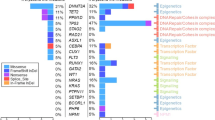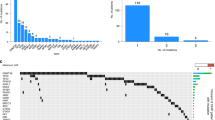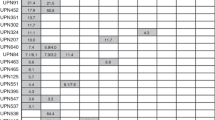Abstract
A serious complication associated with breast cancer treatment is the increased risk for development of therapy-related myeloid neoplasms (t-MN). To determine whether dose-intensive adjuvant regimens for breast cancer induce genetic damage to hematopoietic stem cells, defined by the emergence of clonal hematopoiesis, and whether detection of clonal hematopoiesis could be used as an early marker for the subsequent development of t-MN, the Southwest Oncology Group designed a pilot clonality investigation to estimate the incidence of clonal hematopoiesis during and shortly after completion of the dose-intensive neoadjuvant regimens for high-risk breast cancer patients. Peripheral blood samples from 274 patients obtained prior to treatment, at time of surgery, and at 6 and 12 months post-surgery were examined by two different clonality assays: the HUMARA (HUMan Androgen Receptor) assay to estimate the incidence of early genetic damage by clonal proliferation, and microsatellite instability (MSI) testing to screen for LOH or defective DNA mismatch repair mechanisms. Clonal hematopoiesis was negative in 93.5% of the samples analyzed. Five patients showed a HUMARA-positive/MSI-negative pattern, and no patients showed a HUMARA-negative/MSI-positive pattern. With a median follow-up of 3.1 years, one patient in our study developed t-AML at 3 years 5 months after randomization. Our results indicate that clonal hematopoiesis assays performed within the 2 years following dose-intensive neoadjuvant therapy failed to identify an emerging clonal hematopoietic stem cell population. Longer clinical follow-up will be necessary to define better the positive predictive value of detecting clonal hematopoiesis in the HUMARA+/MSI− cases.




Similar content being viewed by others
References
Vardiman JW, Arber DA, Brunning RD et al (2008) Therapy-related myeloid neoplasm. In: Swerdlow SH, Campo E, Harris NL et al (eds) World Health Organization classification of tumours of haematopoietic and lymphoid tissue. IARC, Lyon
Crump M, Tu D, Shepherd L, Levine M, Bramwell V, Pritchard K (2003) Risk of acute leukemia following epirubicin-based adjuvant chemotherapy: a report from the National Cancer Institute of Canada Clinical Trials Group. J Clin Oncol 1(16):3066–3071. doi:10.1200/JCO.2003.08.137
Hershman D, Neugut AI, Jacobson JS et al (2007) Acute myeloid leukemia or myelodysplastic syndrome following use of granulocyte colony-stimulating factors during breast cancer adjuvant chemotherapy. J Natl Cancer Inst 99(3):196–205. doi:10.1093/jnci/djk028
Le Deley MC, Suzan F, Cutuli B et al (2007) Anthracyclines, mitoxantrone, radiotherapy, and granulocyte colony-stimulating factor: risk factors for leukemia and myelodysplastic syndrome after breast cancer. J Clin Oncol 25(3):292–300. doi:10.1200/JCO.2006.05.9048
Leone G, Pagano L, Ben-Yehuda D, Voso MT (2007) Therapy-related leukemia and myelodysplasia: susceptibility and incidence. Haematologica 92(10):1389–1398. doi:10.3324/haematol.11034
Praga C, Bergh J, Bliss J et al (2005) Risk of acute myeloid leukemia and myelodysplastic syndrome in trials of adjuvant epirubicin for early breast cancer: correlation with doses of epirubicin and cyclophosphamide. J Clin Oncol 23(18):4179–4191. doi:10.1200/JCO.2005.05.029
Smith RE, Bryant J, DeCillis A, Anderson S (2003) Acute myeloid leukemia and myelodysplastic syndrome after doxorubicin-cyclophosphamide adjuvant therapy for operable breast cancer: the National Surgical Adjuvant Breast and Bowel Project Experience. J Clin Oncol 21(7):1195–1204. doi:10.1200/JCO.2003.114
Early Breast Cancer Trialists’ Collaborative Group (EBCTCG) (2005) Effects of chemotherapy and hormonal therapy for early breast cancer on recurrence and 15-year survival: an overview of the randomised trials. Lancet 365(9472):1687–1717. doi:10.1016/S0140.6736(05)66544-0
Mariotto AB, Feuer EJ, Harlan LC, Abrams J (2006) Dissemination of adjuvant multiagent chemotherapy and tamoxifen for breast cancer in the United States using estrogen receptor information: 1975–1999. J Natl Cancer Inst Monogr (36):7–15. doi:10.1093/jncimonographs/lgj0003
Trudeau M, Charbonneau F, Gelmon K et al (2005) Selection of adjuvant chemotherapy for treatment of node-positive breast cancer. Lancet Oncol 6(11):886–898. doi:10.1016/S1470-2045(05)70424-1
Jacobs A (1991) Leukaemia Research Fund annual guest lecture 1990. Genetics lesions in preleukaemia. Leukemia 5(4):277–282
Abrahamson G, Fraser NJ, Boyd J, Craig I, Wainscoat JS (1990) A highly informative X-chromosome probe, M27 beta, can be used for the determination of tumour clonality. Br J Haematol 74(3):371–372. doi:10.1111/j.1365-2141.1990.tb02601.x
Carter G, Hughes DC, Clark RE et al (1990) RAS mutations in patients following cytotoxic therapy for lymphoma. Oncogene 5(3):411–416
Mach-Pascual S, Legare RD, Lu D et al (1998) Predictive value of clonality assays in patients with non-Hodgkin’s lymphoma undergoing autologous bone marrow transplant: a single institution study. Blood 91(12):4496–4503. doi:0006-4971/98/9112-0011$3.00/0
Gale RE, Bunch C, Moir DJ, Patterson KG, Goldstone AH, Linch DC (1996) Demonstration of developing myelodysplasia/acute myeloid leukaemia in haematologically normal patients after high-dose chemotherapy and autologous bone marrow transplantation using X-chromosome inactivation patterns. Br J Haematol 93(1):53–58. doi:10.1046/j.1365-2141.1996.4751014.x
Allen RC, Zoghbi HY, Moseley AB, Rosenblatt HM, Belmont JW (1992) Methylation of HpaII and HhaI sites near the polymorphic CAG repeat in the human androgen-receptor gene correlates with X chromosome inactivation. Am J Hum Genet 51(6):1229–1239
Delabesse E, Aral S, Kamoun P, Varet B, Turhan AG (1995) Quantitative non-radioactive clonality analysis of human leukemic cells and progenitors using the human androgen receptor (AR) gene. Leukemia 9(9):1578–1582
Gale RE, Mein CA, Linch DC (1996) Quantification of X-chromosome inactivation patterns in haematological samples using the DNA PCR-based HUMARA assay. Leukemia 10(2):362–367
Bocker T, Diermann J, Friedl W et al (1997) Microsatellite instability analysis: a multicenter study for reliability and quality control. Cancer Res 57(21):4739–4743
Canzian F, Salovaara R, Hemminki A et al (1996) Semiautomated assessment of loss of heterozygosity and replication error in tumors. Cancer Res 56(14):3331–3337
Edwards A, Hammond HA, Jin L, Caskey CT, Chakraborty R (1992) Genetic variation at five trimeric and tetrameric tandem repeat loci in four human population groups. Genomics 12(2):241–253. doi:0888-7543/923.00
Fey MF (1997) Microsatellite markers in leukaemia and lymphoma: comments on a timely topic. Leuk Lymphoma 28(1–2):11–22. doi:10.3109/10428199709058325
Hoang JM, Cottu PH, Thuille B, Salmon RJ, Thomas G, Hamelin R (1997) BAT-26, an indicator of the replication error phenotype in colorectal cancers and cell lines. Cancer Res 57(2):300–303
Zhou XP, Hoang JM, Cottu P, Thomas G, Hamelin R (1997) Allelic profiles of mononucleotide repeat microsatellites in control individuals and in colorectal tumors with and without replication errors. Oncogene 15(14):1713–1718
Gale RE, Wheadon H, Boulos P, Linch DC (1994) Tissue specificity of X-chromosome inactivation patterns. Blood 83(10):2899–2905
Chen GL, Prchal JT (2007) X-linked clonality testing: interpretation and limitations. Blood 110(5):1411–1419. doi:10.1182/blood-2006-09-018655
Busque L, Mio R, Mattioli J et al (1996) Nonrandom X-inactivation patterns in normal females: lyonization ratios vary with age. Blood 88(1):59–65
Tonon L, Bergamaschi G, Dellavecchia C et al (1998) Unbalanced X-chromosome inactivation in haemopoietic cells from normal women. Br J Haematol 102(4):996–1003. doi:10.1046/j.1365-2141.1998.00863.x
Boudewijns M, van Dongen JJ, Langerak AW (2007) The human androgen receptor X-chromosome inactivation assay for clonality diagnostics of natural killer cell proliferations. J Mol Diagn 9(3):337–344. doi:10.2353/jmoldx.2007.060155
Smith RE (2003) Risk for the development of treatment-related acute myelocytic leukemia and myelodysplastic syndrome among patients with breast cancer: review of the literature and the National Surgical Adjuvant Breast and Bowel Project experience. Clin Breast Cancer 4(4):273–279
Patt DA, Duan Z, Fang S, Hortobagyi GN, Giordano SH (2007) Acute myeloid leukemia after adjuvant breast cancer therapy in older women: understanding risk. J Clin Oncol 25(25):3871–3876. doi:10.1200/JCO.2007.12.0832
Rossi DJ, Bryder D, Seita J, Nussenzweig A, Hoeijmakers J, Weissman IL (2007) Deficiencies in DNA damage repair limit the function of haematopoietic stem cells with age. Nature 447(7145):725–729. doi:10.1038/nature05862
Chambers SM, Shaw CA, Gatza C, Fisk CJ, Donehower LA, Goodell MA (2007) Aging hematopoietic stem cells decline in function and exhibit epigenetic dysregulation. PLoS Biol 5(8):e201. doi:10.1371/journal.pbio.0050201
Choi JK, Kim SC (2007) Environmental effects on gene expression phenotype have regional biases in the human genome. Genetics 175(4):1607–1613. doi:10.1534/genetics.106.069047
Busque L, Paquette Y, Provost S, Roy DC, Levine RL, Mollica L, Gilliland DG (2009) Skewing of X-inactivation ratios in blood cells of aging women is confirmed by independent methodologies. Blood 113(15):3472–3474. doi:10.1182/blood-2008-12-195677
Acknowledgments
This investigation was supported in part by a grant from the Department of Defense, DOD # DAMD17-97-1-7088 and in part by the following PHS Cooperative Agreement grant numbers awarded by the National Cancer Institute, DHHS: CA32102, CA38926, CA58882, CA86780, CA14028, CA20319, CA52654, CA63845, CA379891, CA63844, CA22433, CA35431, CA76448, CA35176, CA58861, CA46441, CA35178, CA67575, CA45808, CA12644, CA11083, CA35192, CA76447, CA46282, CA45560, CA04919, CA45377, CA35090, CA74811, CA95860, CA35281, CA74647, CA76462, CA35128, CA76462, CA46136, and CA35119. The authors also thank Mr. Aaron Theisen for assistance in paper preparation.
Author information
Authors and Affiliations
Corresponding author
Rights and permissions
About this article
Cite this article
Slovak, M.L., Bedell, V., Lew, D. et al. Screening for clonal hematopoiesis as a predictive marker for development of therapy-related myeloid neoplasia (t-MN) following neoadjuvant therapy for breast cancer: a Southwest Oncology Group study (S0012). Breast Cancer Res Treat 119, 391–398 (2010). https://doi.org/10.1007/s10549-009-0597-5
Received:
Accepted:
Published:
Issue Date:
DOI: https://doi.org/10.1007/s10549-009-0597-5




